Breast Revision
Wake Plastic Surgery proudly serves Cary, Raleigh, and the surrounding areas.
Unfortunately, patients that have one breast surgery are very likely to require another. This is less true with breast reduction and breast lift surgeries without implants. But patients that have breast implants are at significant risk of needing a revision procedure at some point in time.
Breast Revision Highlights
-

- BMI of 32
and below
-

- 1 Week
out of work
-

- 4-6 Week
Recovery Period
-

- Consultation Required
for Cost
Why choose Wake Plastic Surgery?
Revision breast surgery can be frustrating. Dr. Stoeckel and Dr. Barry understand this frustration and will be able to effectively communicate the options for improvement in an understanding and clear way. Often, the best solution is only obvious when the root problem is fully understood. Dr. Stoeckel and Dr. Barry are proficient in clearly identifying these problems, explain them in an easy to understand manner, and work together with you to create the best plan to correct the issues at hand.
Our Breast Revision ResultsWhat types of complications are seen after breast surgery?
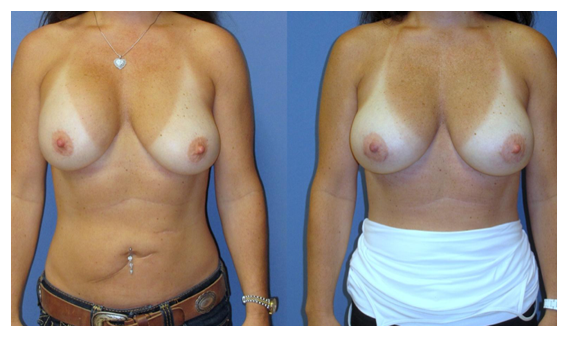
Right side capsular contracture treated with new implants and pocket exchange
Capsular contracture
Capsular contracture is probably the most annoying complication associated with breast augmentation. When an implant is placed, the body recognizes it as a foreign object and creates a thin film of connective tissue around it to separate the implant from the rest of the body. This is called the implant capsule. For most patients, the implant capsule remains thin, soft, and natural. But for others, the capsule can become thick, firm, and problematic. The cause of the contracture is still not certain. Ensuring strict sterile technique during surgery may reduce some of the risk. But there also appears to be a genetic factor that is not fully understood.
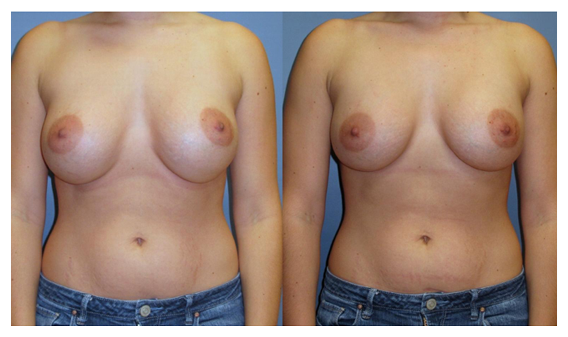
Capsulorrhaphy procedure to correct inferior malposition
Bottoming out
Inferior malposition or “bottoming out” is when an implant is palpable below the natural breast crease. This can be the result of over-aggressive dissection during surgery. It can be caused by the use of breast implants that are too big for the natural breast fold to support. Or it can be the result of a patient having tissue that is simply not strong enough to support an implant of any size. Dr. Stoeckel has a unique technique of re-establishing or supporting a breast crease with internal permanent sutures that can effectively correct the problem of inferior malposition.
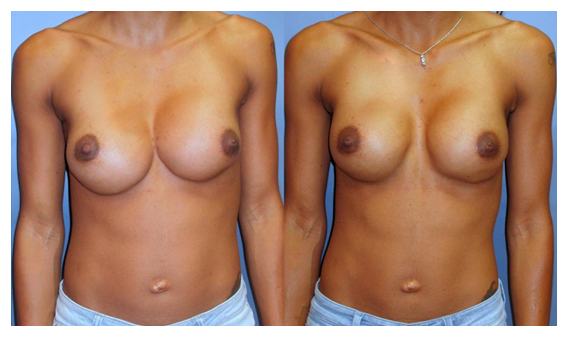
Medial malposition corrected with internal suture pocket revision
Medial malposition
Medial malposition is when a breast implant is too close to the midline. An extreme case of this is when the breast implants appear to be touching in the middle. This is referred to as symmastia or a “uni-boob”. This problem can make the nipples appear to be positioned on the very outside edge of the breasts. Dr. Stoeckel can effectively correct this condition with the use of internal sutures similar to those used to correct inferior malposition.
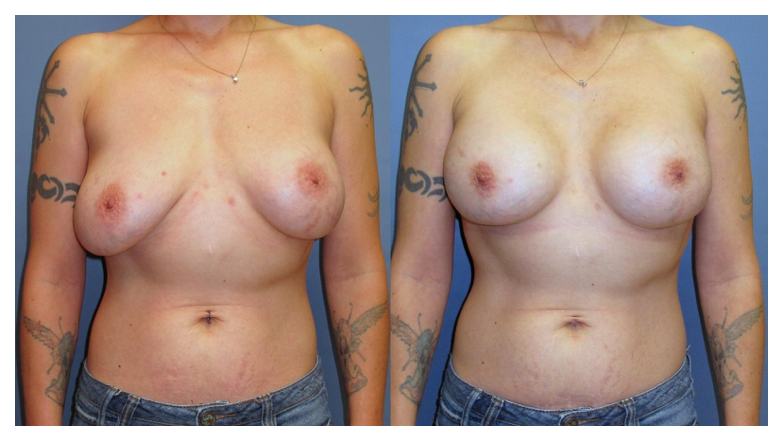
Capsulorrhaphy procedure used to correct lateral malposition
Lateral malposition
Lateral malposition occurs when a breast implant slides too far to the outside on the chest wall. Some patients feel that the implants seem to be in the armpits, especially when lying down. This condition can also be corrected with capsulorrhaphy sutures or with changing the pocket position of the implants.
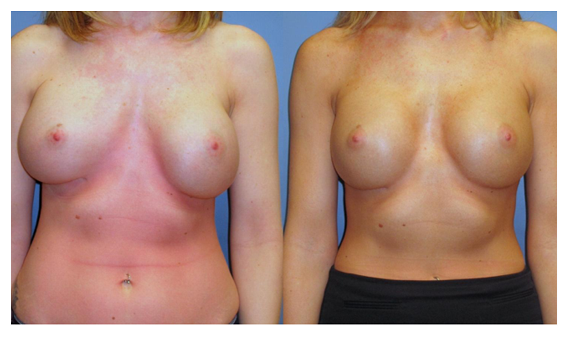
Overfilled and incorrectly positioned implants that were exchanged and placed into new and proper pockets
Implant position asymmetry
Asymmetry can result when one implant does not settle enough over time or when one implant settles too much. It can result from poor surgical technique by the surgeon as well. Correction of the problem all depends on the particular issue. Most often, the procedure to correct will involve pocket revision or change and implant replacement.
What does it look like if I just want to remove my implants?
For many reasons, some women simply want to remove their existing implants without replacing them. Implant removal is often a very simple procedure that can often be completed with just local anesthesia. Breast implants always cause stretching of the skin envelope over time and removal of implants will almost always result in a somewhat “deflated” appearance. The degree of skin retraction after implant removal depends on the skin quality, size of the implants, age, and genetics.
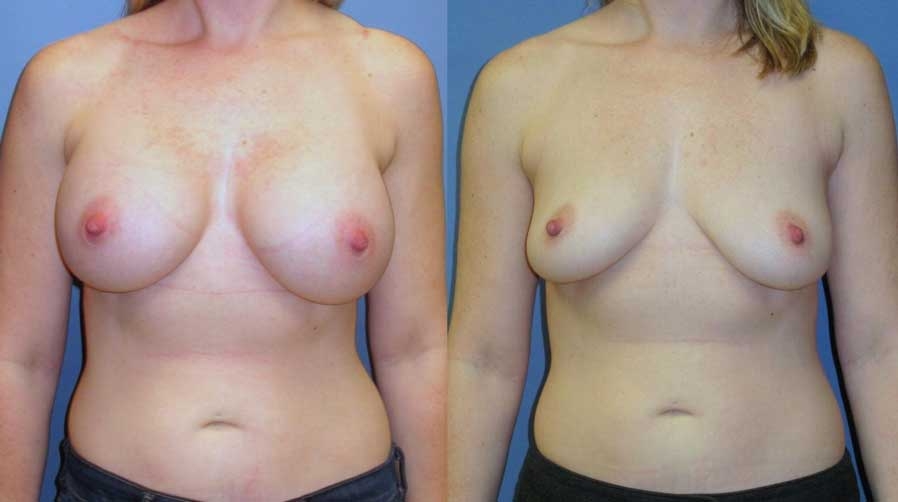
Implant removal after 1 month. The 300 cc implants were placed 5 years previously.
What is involved with removal and replacement of implants?
Many patients would like to remove their existing implants and replace them with new ones. In some cases, switching out implants is very straightforward and requires very little time or recovery. But for others, the removal and replacement surgery is quite complex and much more difficult than the original implant placement procedure. In most instances, patients are interested in changing the implant volume, pocket location, and possibly combining the exchange with a breast lift procedure. Implant ruptures, capsular contractures, and calcifications can increase the complexity of the implant exchange procedure. The surgery is further complicated when the original implants are oversized and placed in the subglandular position (over the muscle).
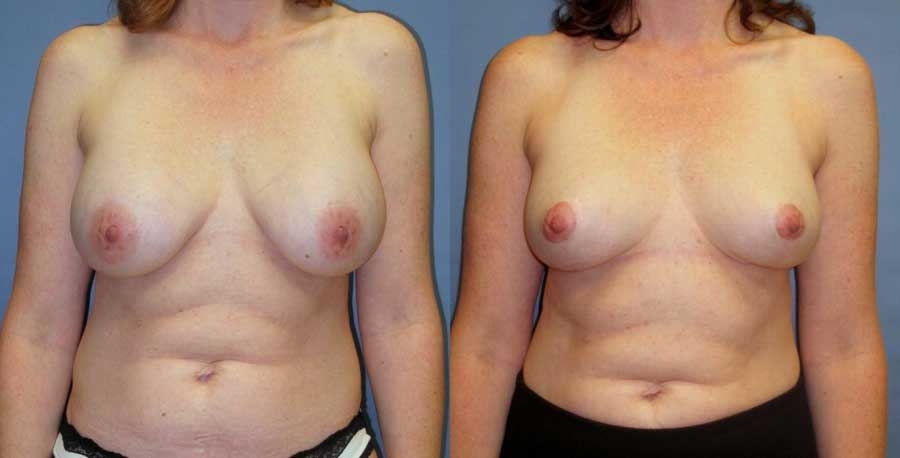
Implant exchange and vertical mastopexy. 350 cc implants were removed and replaced with 200 cc implants
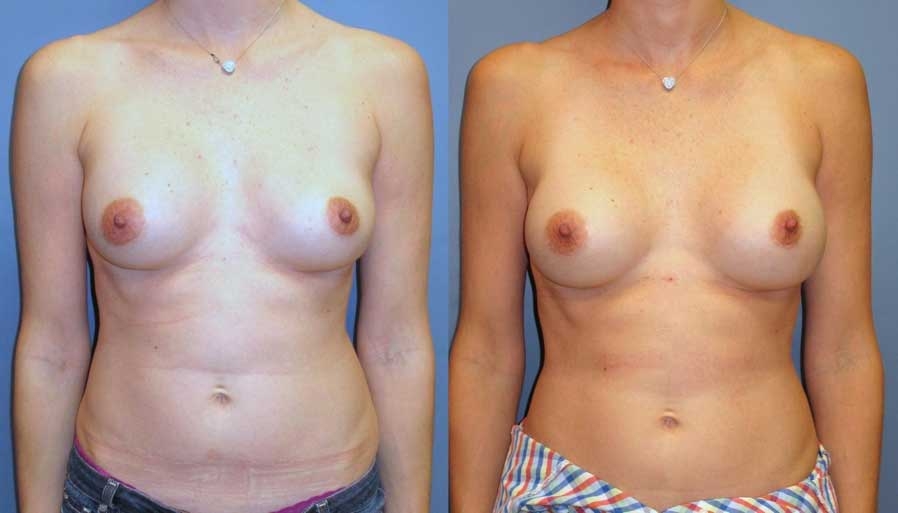
Removal of 300 cc implants and replacement with 325 cc implants
How is a capsular contracture treated?
If a capsular contracture develops, surgery may be required to improve the appearance and feel of the breast implant. There are many different ways to try to correct capsular contractors. The capsule an be incised and released (capsulotomy), it can be removed completely (capsulectomy), or the implant can be removed and the capsule collapsed upon itself. Each of these procedures has their risks and benefits. Mild capsular contractors may respond to medications such as Singulair and Accolate, which are drugs typically used to treat patients with asthma.
Schedule A Consultation